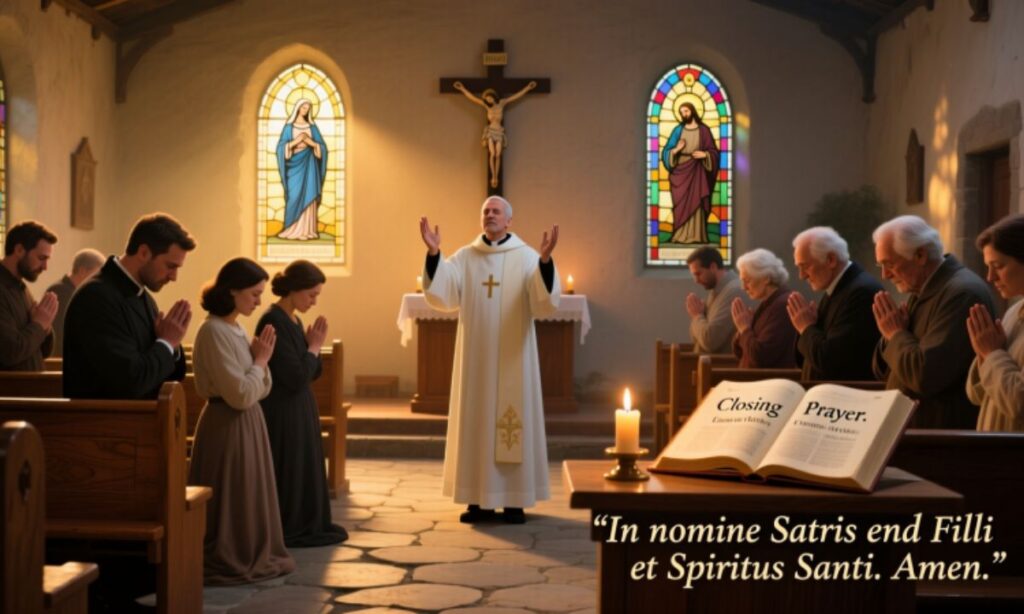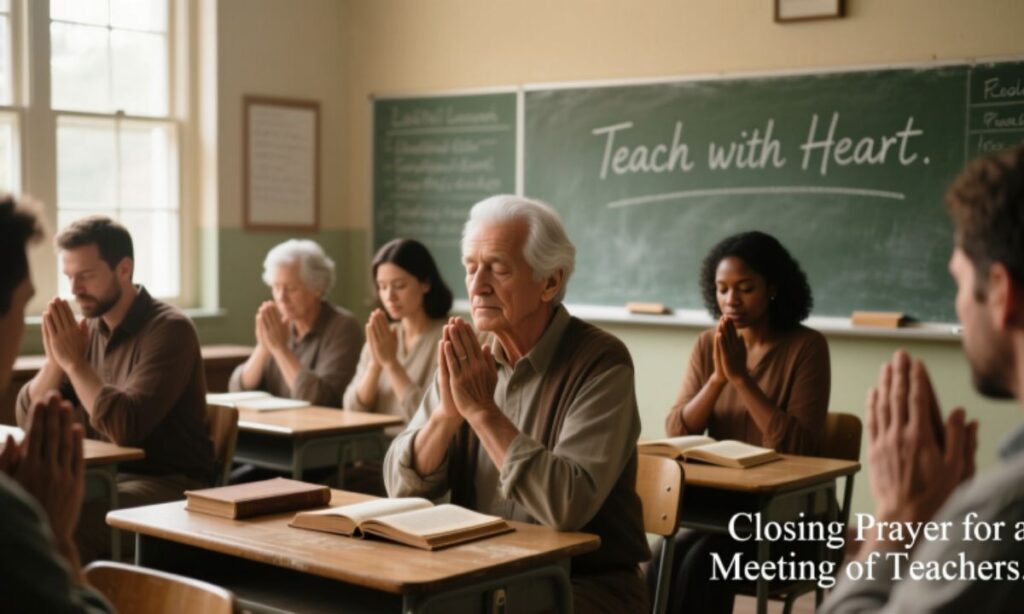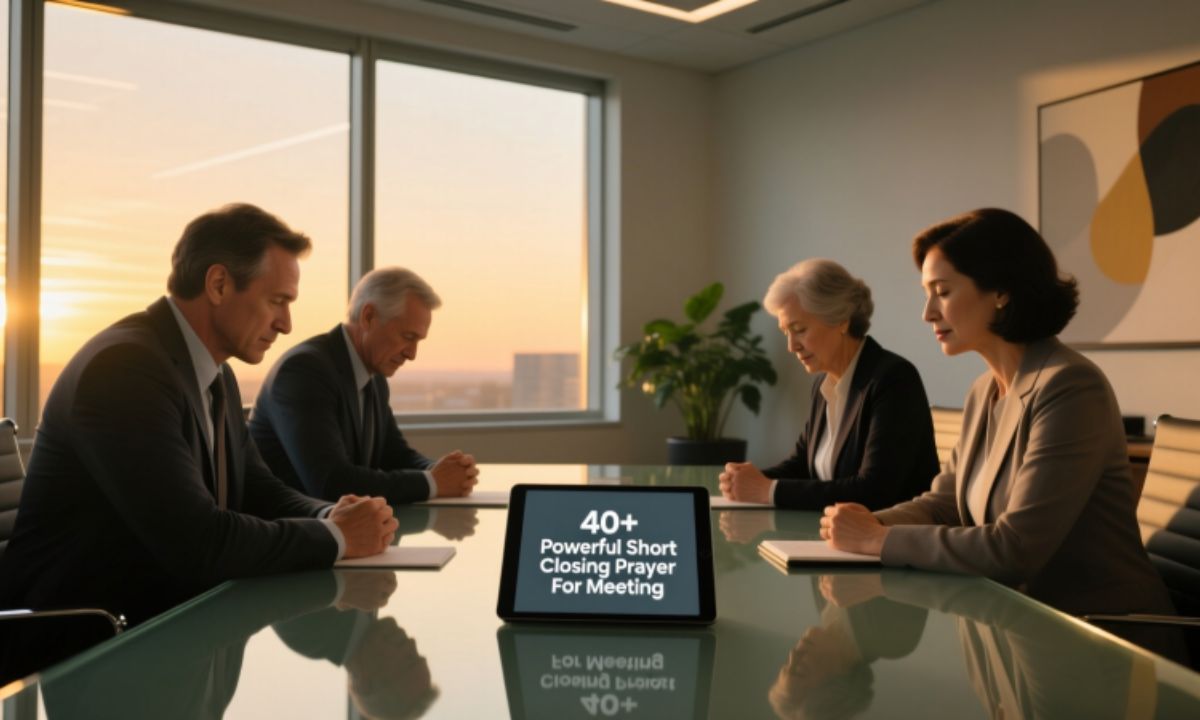Meetings bring people together for ideas, planning, and decisions. As they end, it is important to close with gratitude and peace. A short closing prayer helps everyone leave with clarity. It also reminds us that unity and respect matter most.
A powerful short closing prayer sets the right tone for farewell. It can ask for wisdom, guidance, and blessings on the work done. Such prayers strengthen faith and teamwork. They leave hearts calm, thankful, and ready for what lies ahead.
Understanding the Power of Closing Prayers
A closing prayer for meeting serves multiple purposes beyond spiritual connection. It creates a moment of collective pause in our fast-paced world. It acknowledges the contributions of all participants. It provides emotional closure to discussions and decisions.
These prayers don’t need to be lengthy to be effective. A short prayer for meeting can be just as powerful as an extended reflection. The key lies in sincerity and intentionality. When spoken with genuine faith and purpose, even a few sentences can uplift spirits and unite hearts.
The beauty of closing prayers is their universal appeal. While rooted in faith traditions, they speak to fundamental human needs: connection, gratitude, and hope. They remind us that our work extends beyond immediate tasks. They ground us in values that transcend daily challenges.
Examples of Short Closing Prayers
Prayer of Gratitude and Unity
“Gracious Creator, As we bring this meeting to a close, We offer thanks for the time shared. May the insights gained and decisions made Propel us towards our shared goals. Grant us wisdom in our endeavors, Strength in our unity, And compassion in our interactions. Though we depart, our bonds remain strong. Amen.”
This prayer for gratitude acknowledges collective effort while looking forward to future collaboration. It emphasizes three core values: wisdom, strength, and compassion. These elements create a foundation for continued teamwork.
Prayer of Hope and Collaboration
“Divine Light, In this moment of departure, We pause to honor the connections forged. May the seeds of collaboration planted today Blossom into fruitful outcomes tomorrow. Grant us the grace to navigate challenges, The humility to seek understanding, And the courage to act with integrity. As we go our separate ways, May our shared purpose continue to unite us. Amen.”
This prayer for collaboration uses agricultural metaphor to symbolize growth and potential. It recognizes that meetings are starting points, not endpoints. The emphasis on grace, humility, and courage provides practical spiritual guidance.
Prayer of Diversity and Respect
“Source of Compassion, As we conclude our time together, We express gratitude for the diversity of voices present. May the richness of our perspectives Inspire deeper understanding and empathy. Bless our shared efforts with harmony, Our decisions with discernment, And our actions with kindness. Though we part ways, may our connections endure, Nurtured by the spirit of respect and goodwill. Amen.”
This prayer for unity celebrates different perspectives while calling for harmony. It’s particularly effective for diverse teams or interfaith gatherings. The focus on respect and goodwill creates inclusive space.
Prayer of Courage and Connection
“Guiding Spirit, As we prepare to depart, We offer thanks for the time shared in community. May the bonds formed today Serve as pillars of support in times of need. Grant us the courage to embrace change, The patience to listen deeply, And the resilience to persevere. Though our paths diverge, our spirits remain connected, Anchored by the values that unite us. Amen.”
This prayer for guidance acknowledges life’s uncertainties while affirming lasting connections. It prepares participants for challenges ahead. The emphasis on courage, patience, and resilience provides strength.
Closing Prayer for a Catholic Meeting

Scripture Foundation:
“May the grace of the Lord Jesus Christ, the love of God, and the fellowship of the Holy Spirit be with you all.” – 2 Corinthians 13:14
Prayer
Heavenly Father, we come before You at the close of this meeting with hearts full of gratitude. We thank You for the wisdom, guidance, and unity You have bestowed upon us today. Your presence has been with us in our discussions, decisions, and interactions.
Lord, as we leave this place, we ask for Your continued blessing and protection over each one of us. May the seeds of ideas and plans we have sown today grow and bear fruit, guided by Your divine will. Grant us the grace to carry out our duties with integrity, compassion, and dedication.
We entrust our hopes and efforts to Your loving care. Help us to remain steadfast in our faith, and let our actions reflect Your love and mercy to those we encounter. May we always seek to serve You and our community with humility and joy. Through Christ our Lord, Amen.
Declaration
May the peace of God, which surpasses all understanding, guard our hearts and minds in Christ Jesus. Let us go forth in confidence, knowing that we are guided and protected by our Heavenly Father. Amen.
This short Catholic prayer follows traditional liturgical structure while remaining accessible. The combination of prayer and declaration provides both petition and affirmation. It’s ideal for Catholic organizations, church committees, or faith-based groups.
Closing Prayer for an Online Meeting
Scripture Foundation:
“The Lord blesses you and keeps you; the Lord makes his face shine on you and be gracious to you.” – Numbers 6:24-25
Prayer
Heavenly Father, we thank You for being with us during this online meeting. Your guidance and presence have made our discussions fruitful and our decisions wise.
As we conclude, we ask for Your continued blessings upon each of us. Keep us safe, healthy, and steadfast in our purpose. May we carry the insights and resolutions from this meeting into our daily lives, working diligently and faithfully. Through Christ our Lord, Amen.
Declaration
May the Lord bless us and keep us, and may His face shine upon us, now and always. Amen.
This prayer for online meeting acknowledges digital gathering’s unique nature while maintaining spiritual depth. It’s brief enough for virtual attention spans yet meaningful. The focus on safety and health reflects contemporary concerns.
Virtual meetings have become standard in modern work life. They require adapted practices that honor both technology and tradition. This prayer bridges physical distance through spiritual connection. It reminds participants that divine presence transcends digital platforms.
Closing Prayer for a Meeting of Teachers

Scripture Foundation:
“And let us consider how we may spur one another on toward love and good deeds.” – Hebrews 10:24
Prayer
Heavenly Father, we come before You at the close of this meeting with grateful hearts. We thank You for the opportunity to gather and collaborate as educators, sharing our insights and experiences for the betterment of our students. Your wisdom has guided our discussions, and Your presence has united us in our mission.
Lord, as we leave this place, we ask for Your continued blessings upon each of us. Strengthen us to carry out our responsibilities with patience, creativity, and dedication. Help us to inspire and nurture our students, fostering their growth in knowledge and character.
We entrust our efforts to Your care, knowing that with Your guidance, we can make a positive impact in the lives of those we teach. May our work be a reflection of Your love and commitment to education. Through Christ our Lord, Amen.
Declaration
May the Lord bless us with wisdom, patience, and a spirit of collaboration as we continue our work as educators. Let us go forth with confidence, knowing that we are supported and guided by our Heavenly Father. Amen.
This prayer for teachers meeting honors education’s sacred calling while addressing practical challenges. Teachers face unique pressures requiring spiritual support. The emphasis on patience, creativity, and dedication speaks to daily classroom realities.
Education shapes future generations, making teacher collaboration crucial. This prayer acknowledges collective responsibility while offering individual encouragement. It connects pedagogical work to divine purpose.
Short Closing Prayer for Work
Scripture Foundation:
“Commit to the Lord whatever you do, and He will establish your plans.” – Proverbs 16:3
Prayer
Heavenly Father, we thank You for Your presence with us throughout this workday. We are grateful for the guidance, strength, and wisdom You have provided in our tasks and interactions.
As we close this day, we ask for Your continued blessings upon our work. Grant us rest and rejuvenation, and prepare us for the challenges and opportunities of tomorrow. May our efforts today bear good fruit and bring glory to Your name.
Through Christ our Lord, Amen.
Declaration
May the Lord bless and sustain us as we conclude our workday. Let us go forth with peace and confidence, knowing that we are guided and protected by our Heavenly Father. Amen.
This short prayer for work addresses workplace spirituality in practical terms. It acknowledges daily labor’s dignity while seeking divine blessing. The focus on rest recognizes work-life balance importance.
Modern workplaces need spiritual grounding amid constant pressure. This prayer provides brief yet meaningful closure. It helps transition from professional to personal time.
Key Elements of Effective Closing Prayers

Effective closing prayers share common characteristics that make them memorable and meaningful. Understanding these elements helps leaders craft appropriate prayers for specific contexts.
Gratitude forms the foundation of most closing prayers. Expressing thanks for time together, insights gained, and connections made sets a positive tone. It shifts focus from problems to blessings.
Inclusivity ensures all participants feel respected regardless of specific beliefs. Using universal language about guidance, wisdom, and unity creates welcoming space. This doesn’t dilute faith but expands embrace.
Brevity maintains attention and respects time constraints. Short prayers pack maximum impact into minimum words. They’re easier to remember and repeat.
Forward-looking perspective connects present gathering to future action. Effective prayers don’t just close meetings but launch participants into continued purpose. They bridge discussion and implementation.
Specific relevance addresses particular meeting contexts. Teacher prayers differ from business prayers. Customization shows thoughtfulness and enhances meaning.
Benefits of Incorporating Closing Prayers
- Creates meaningful closure to discussions and decisions
- Fosters team unity and shared purpose
- Reduces stress through moment of peace
- Acknowledges contributions of all participants
- Provides spiritual grounding in secular environments
- Encourages reflection on meeting outcomes
- Strengthens community bonds among diverse members
- Offers hope for future collaboration
- Sets positive tone for departure
- Reminds participants of higher purpose beyond immediate tasks
Organizations that regularly use closing prayers report improved team cohesion. Participants feel more valued and connected. The practice creates ritual that marks transitions.
Research shows brief spiritual practices reduce workplace stress. They provide mental break from constant problem-solving. This paradoxically improves productivity by preventing burnout.
How to Lead a Closing Prayer
Leading a closing prayer requires sensitivity and preparation. Not everyone is comfortable with public prayer. Following these guidelines ensures respectful, effective delivery.
Announce intention before beginning so participants can prepare mentally. A simple “Let’s close with a brief prayer” provides necessary transition. This respects different comfort levels.
Speak clearly and slowly allowing words to resonate. Rushed prayers lose impact. Pausing between phrases creates space for reflection.
Make eye contact or invite head bowing depending on context and tradition. Physical posture enhances spiritual focus. It signals shift from discussion to prayer.
Use inclusive language that respects diverse beliefs while maintaining authenticity. Balance specificity with universality. This requires thoughtful word choice.
Keep it brief unless occasion calls for extended prayer. Generally, 30-60 seconds suffices for meeting closures. Longer prayers risk losing attention.
End clearly with traditional closing like “Amen” so participants know prayer concluded. This provides clean transition back to regular interaction.
Adapting Prayers for Different Contexts
Different meetings require adapted prayer approaches. Corporate gatherings differ from educational settings. Understanding context improves prayer effectiveness.
Corporate Meetings
Workplace prayers should emphasize productivity, ethical decision-making, and team collaboration. Avoid overly religious language in mixed-faith environments. Focus on universal values like integrity and excellence.
Educational Settings
Prayer for educators can address student welfare, learning outcomes, and teacher resilience. These prayers acknowledge education’s noble calling. They can be more explicit about faith in religious schools.
Community Gatherings
Community meeting prayers celebrate diversity while seeking common ground. They emphasize unity amid differences. These prayers often address social concerns and collective wellbeing.
Virtual Meetings
Online meeting prayers acknowledge technology’s role while transcending digital limitations. They’re typically shorter given screen fatigue. They may specifically mention health and connection.
Interfaith Settings
Interfaith prayers use language embracing multiple traditions. Terms like “Divine Spirit” or “Source of All” provide flexibility. Focus on shared values rather than specific doctrines.
Scripture-Based Closing Prayers

Incorporating scripture adds depth and authority to closing prayers. Biblical verses provide timeless wisdom applicable to modern contexts.
Popular scriptures for meeting closures include:
- Philippians 4:7
“And the peace of God, which transcends all understanding, will guard your hearts and minds”
- Psalm 90:17
“May the favor of the Lord our God rest on us; establish the work of our hands”
- Proverbs 3:5-6
“Trust in the Lord with all your heart and lean not on your own understanding”
- Matthew 18:20
“Where two or three gather in my name, there am I with them”
- Romans 15:13
“May the God of hope fill you with all joy and peace”
Using scripture grounds prayers in tradition while speaking to contemporary needs. Biblical language carries weight even in secular settings. It connects present gatherings to ancient wisdom.
Creating Your Own Closing Prayers
Developing personalized closing prayers enhances authenticity and relevance. While templates help, original prayers reflect specific contexts and needs.
Start with gratitude for the specific gathering. Mention particular accomplishments or discussions. This shows attentiveness to meeting content.
Acknowledge challenges faced by participants. Honest prayers resonate more than idealistic ones. This demonstrates empathy and realism.
Request specific guidance relevant to decisions made or tasks ahead. Generic prayers lack impact. Specificity shows care.
Include hopeful vision for outcomes of the meeting. Paint picture of positive future. This motivates action.
Close with blessing over participants as they depart. Send them forth with confidence. This provides encouraging conclusion.
Cultural Sensitivity in Closing Prayers
Cultural awareness ensures prayers respect all participants. In increasingly diverse settings, this sensitivity is essential.
Research participants’ backgrounds when possible. Understanding religious demographics informs appropriate language. This shows respect and builds trust.
Avoid assuming everyone shares your faith tradition. Even in predominantly Christian settings, beliefs vary. Inclusive language welcomes everyone.
Offer opt-out gracefully. Some may prefer not participating in prayer. Respecting this strengthens rather than weakens community.
Consider silent prayer as alternative. This allows individual expression within group practice. Everyone participates in own way.
Learn basic prayer practices from different traditions. This knowledge enhances cross-cultural competence. It prevents unintentional offense.
The Psychology of Closing Rituals
Closing rituals like prayer serve important psychological functions. They provide cognitive closure helping brain process experiences.
Humans need clear beginnings and endings. Prayers mark transitions effectively. This satisfies deep psychological need for structure.
Collective rituals strengthen social bonds through shared experience. Praying together creates sense of belonging. This improves team dynamics.
Moments of reflection enhance learning retention. Prayer provides this pause naturally. Participants remember meetings with closing prayers more vividly.
Emotional regulation occurs through prayer’s calming effect. Stepping back from intense discussion reduces stress. This promotes healthier work environments.
Overcoming Hesitation About Prayer

Some leaders hesitate incorporating prayer into meetings fearing controversy or discomfort. Understanding concerns helps address them appropriately.
Separation of church and state concerns arise in government settings. Know legal boundaries. When appropriate, opt for moment of silence instead.
Diverse beliefs seem challenging to accommodate. Actually, well-crafted prayers can honor diversity. Focus on common values everyone shares.
Personal discomfort with public prayer affects some leaders. Practice builds confidence. Starting with brief, simple prayers eases anxiety.
Time constraints seem to prohibit prayer. Actually, 30-second prayer saves time by providing clean closure. It prevents drawn-out farewells.
Fear of offending paralyzes some leaders. Transparent communication prevents offense. Explaining prayer’s purpose helps participants understand.
Digital Age Considerations
The digital age requires adapted approaches to closing prayers. Technology changes how we gather but not why prayers matter.
Virtual meetings benefit from prayers just as in-person ones do. Screen fatigue makes brief closures especially valuable. Prayer provides needed mental break.
Recording prayers raises privacy concerns. Announce when recording and offer opt-out. Respect those uncomfortable being recorded.
Chat features allow silent participation. Some may type “Amen” rather than speaking. This accommodates different comfort levels.
Time zones complicate scheduling making efficient closures crucial. Brief prayer respects participants’ varying schedules. It acknowledges global nature of modern work.
Monthly and Annual Closing Prayers
Some meetings occur regularly requiring varied prayers. Repeating same prayer becomes rote. Creating rotation maintains freshness.
Monthly meetings might follow liturgical calendar for faith-based organizations. Seasonal themes provide natural variation. This connects work to broader spiritual rhythms.
Annual gatherings deserve more elaborate closing prayers. Year-end reflections acknowledge accumulated achievements. They set vision for coming year.
Quarterly reviews can include prayers addressing specific business cycles. These connect spiritual and practical concerns. They ground strategic planning in values.
Creating prayer calendar ensures variety while maintaining quality. Assign different team members to prepare prayers. This distributes responsibility and includes diverse voices.
Training Others to Lead Closing Prayers
Developing prayer leaders within organizations ensures sustainability. Not everyone naturally excels at public prayer. Training builds competence and confidence.
Provide templates and examples like those in this guide. Seeing effective models helps new leaders. They can adapt rather than starting from scratch.
Practice in low-stakes settings before leading major meetings. Small group prayer builds skills. Feedback helps improve delivery.
Emphasize authenticity over eloquence. Heartfelt simple prayers outperform impressive but hollow ones. Sincerity matters most.
Teach basic structure: gratitude, petition, blessing. This framework prevents rambling. It ensures prayers stay focused.
Encourage personal voice rather than mimicry. Each leader brings unique perspective. Diversity enriches prayer life.
Combining Prayer with Other Closing Practices
Closing prayers work well alongside other closing practices. Integration creates richer conclusions.
Recognition of contributions can precede prayer. Acknowledging individuals by name shows appreciation. Prayer then consecrates these efforts.
Action item review ensures practical follow-through before spiritual reflection. This balances temporal and eternal concerns. It prevents prayer from seeming disconnected.
Next meeting scheduling provides logistical clarity before prayer. Handling business first allows prayer to focus spiritually. This respects prayer’s distinct purpose.
Fellowship time after prayer extends connection. Informal conversation deepens relationships. Prayer launches rather than ends interaction.
Impact on Organizational Culture
Regular closing prayers shape organizational culture profoundly. They signal values beyond profit or productivity.
Organizations using prayers report stronger ethical cultures. Regular spiritual reflection reinforces moral decision-making. This prevents values from becoming mere rhetoric.
Employee satisfaction often increases with meaningful rituals. People want purpose beyond paychecks. Prayer addresses this fundamental need.
Leadership credibility grows when leaders authentically embrace spiritual practices. This requires genuine faith not performative religion. People detect insincerity quickly.
Retention improves in organizations with strong rituals. People feel connected to something larger. This loyalty transcends compensation.
Frequently Asked Questions
What is a Powerful Short Closing Prayer For Meeting?
It is a brief prayer to thank God and ask for guidance as a meeting ends.
Can you give me a Powerful Short Closing Prayer For Meeting?
Yes, a simple prayer of gratitude and blessing works well for closing.
Why use a Powerful Short Closing Prayer For Meeting?
It brings peace, unity, and a sense of direction after discussions.
How do you say a Powerful Short Closing Prayer For Meeting?
Keep it short, thankful, and focused on guidance and blessings.
Where can I find examples of a Powerful Short Closing Prayer For Meeting?
You can find many short and meaningful prayers in articles or prayer guides.
Conclusion
As meetings come to an end, a Powerful Short Closing Prayer For Meeting leaves everyone with peace and gratitude. It helps carry the lessons, ideas, and teamwork beyond the room. A simple prayer not only closes the session with purpose but also opens the way for future blessings.
Through prayer, hearts are united and strengthened to face what comes next. It is more than words it is a reminder of faith, guidance, and hope. Ending with a powerful prayer ensures that the meeting is not just finished but truly fulfilled.

Hi, I’m Michael Grant. I have 4 years of experience writing for BibleTruthsNow.com, sharing insights on prayer, Bible meaning, and faith to encourage believers in their spiritual journey.


